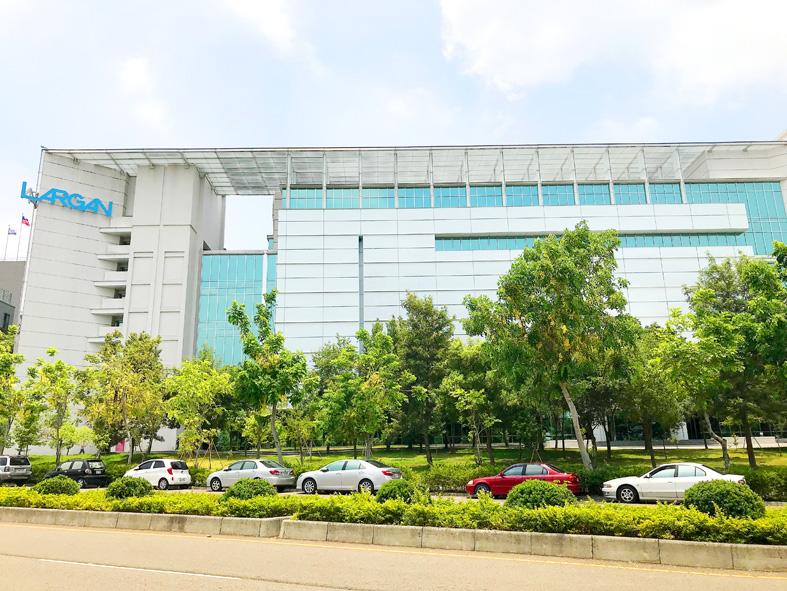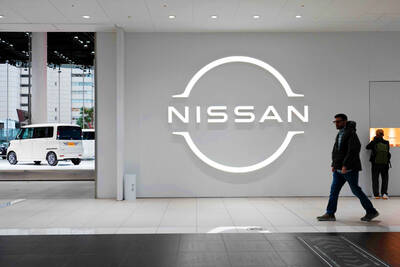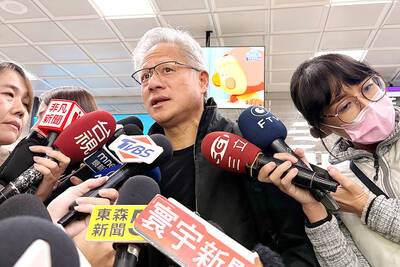Last month’s revenue at Largan Precision Co (大立光) was the highest the smartphone camera lens supplier had posted in 10 months and marks the sixth consecutive month of growth, the company said yesterday.
Consolidated revenue rose 3.54 percent month-on-month to NT$4.35 billion (US$156.9 million), the highest since January, when the company posted NT$4.61 billion in revenue, Largan data showed.
The results reflected that the firm was ramping up production as the industry enters its peak season and customers launch new models.

Photo: Chen Mei-ying, Taipei Times
However, last month’s figure was 16.94 percent lower than the NT$5.24 billion it posted a year earlier, as component shortages and continued effects of the COVID-19 pandemic prompted smartphone brands to postpone camera upgrades, Largan said.
Analysts said that the company’s Chinese clients remained unable to make up for the loss of orders from Huawei Technologies Co (華為), which is affected by US sanctions that also influenced Largan’s average selling prices and shipping volume.
Taichung-based Largan counts Apple Inc, Sony Corp and Samsung Electronics Inc among its customers.
High-margin lenses for cameras of 20 or more megapixels accounted for 10 to 20 percent of its total shipments last month, lenses for products of 10 megapixels or more contributed 50 to 60 percent, lenses for 8-megapixel products made up 10 percent and other lenses for products with lower resolutions contributed 20 to 30 percent, Largan’s shipment breakdown showed.
As a leading maker of optical lens modules, Largan also produces real-image viewfinders and other optoelectronic parts.
The company’s cumulative revenue for the first 11 months of this year dropped 16.79 percent year-on-year to NT$42.46 billion.
Largan remains a leader in the lens industry, but the overall smartphone supply chains are still facing uncertainties amid tight supply for some components and the lingering pandemic in the near term, analysts said.
For this quarter, Largan’s revenue is forecast to grow 9 percent quarter-on-quarter, but fall 15 percent year-on-year to NT$13 billion, due mainly to its US clients losing market share, price pressure and weaker demand from Android-based smartphone brands, Yuanta Securities Investment Consulting Co (元大投顧) said in a research note last month.
Due to slowing specification upgrades, rising competition from rivals and continued pressure on its gross margin, Largan shares have declined 37.56 percent so far this year.
The shares closed 0.99 percent lower at NT$1,995 on Friday in Taipei trading, Taiwan Stock Exchange data showed.
Largan’s board of directors on Oct. 25 approved the company’s first buyback program for two months, aiming to buy back up to 1.342 million shares — or 1 percent of its outstanding shares — on the open market from Oct. 26 to Dec. 24 at NT$2,025 to NT$3,300 per share.
The company has thus far repurchased 580,000 shares for NT$2,090 on average, spending a total of NT$1.21 billion, its regulatory filings showed.

Nissan Motor Co has agreed to sell its global headquarters in Yokohama for ¥97 billion (US$630 million) to a group sponsored by Taiwanese autoparts maker Minth Group (敏實集團), as the struggling automaker seeks to shore up its financial position. The acquisition is led by a special purchase company managed by KJR Management Ltd, a Japanese real-estate unit of private equity giant KKR & Co, people familiar with the matter said. KJR said it would act as asset manager together with Mizuho Real Estate Management Co. Nissan is undergoing a broad cost-cutting campaign by eliminating jobs and shuttering plants as it grapples

TEMPORARY TRUCE: China has made concessions to ease rare earth trade controls, among others, while Washington holds fire on a 100% tariff on all Chinese goods China is effectively suspending implementation of additional export controls on rare earth metals and terminating investigations targeting US companies in the semiconductor supply chain, the White House announced. The White House on Saturday issued a fact sheet outlining some details of the trade pact agreed to earlier in the week by US President Donald Trump and Chinese President Xi Jinping (習近平) that aimed to ease tensions between the world’s two largest economies. Under the deal, China is to issue general licenses valid for exports of rare earths, gallium, germanium, antimony and graphite “for the benefit of US end users and their suppliers

PERSISTENT RUMORS: Nvidia’s CEO said the firm is not in talks to sell AI chips to China, but he would welcome a change in US policy barring the activity Nvidia Corp CEO Jensen Huang (黃仁勳) said his company is not in discussions to sell its Blackwell artificial intelligence (AI) chips to Chinese firms, waving off speculation it is trying to engineer a return to the world’s largest semiconductor market. Huang, who arrived in Taiwan yesterday ahead of meetings with longtime partner Taiwan Semiconductor Manufacturing Co (TSMC, 台積電), took the opportunity to clarify recent comments about the US-China AI race. The Nvidia head caused a stir in an interview this week with the Financial Times, in which he was quoted as saying “China will win” the AI race. Huang yesterday said

Dutch chipmaker Nexperia BV’s China unit yesterday said that it had established sufficient inventories of finished goods and works-in-progress, and that its supply chain remained secure and stable after its parent halted wafer supplies. The Dutch company suspended supplies of wafers to its Chinese assembly plant a week ago, calling it “a direct consequence of the local management’s recent failure to comply with the agreed contractual payment terms,” Reuters reported on Friday last week. Its China unit called Nexperia’s suspension “unilateral” and “extremely irresponsible,” adding that the Dutch parent’s claim about contractual payment was “misleading and highly deceptive,” according to a statement